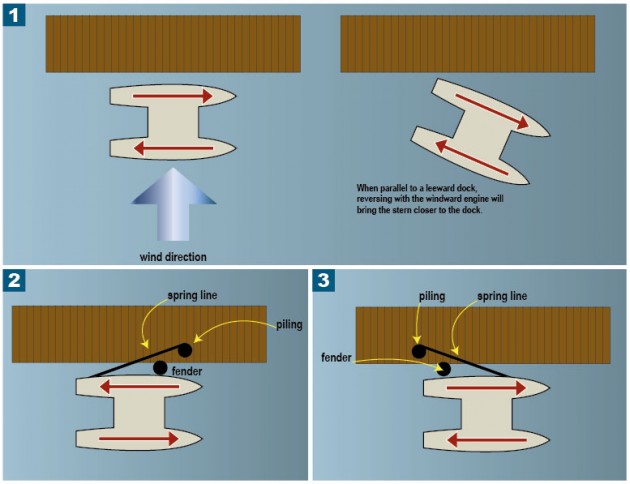Docking a catamaran
Keep a wide beam under control with the power of twin engines
Bringing a catamaran to the dock can intimidate sailors used to maneuvering boats with half the beam or less. As multihulls become the boat of choice for charterers it's good know the basics of docking a catamaran so you can come in off the mooring and head to the dock without calling for help.
Catamarans have an advantage when it comes to maneuvering in that the propellers are mounted well outboard, maximizing the turning force. However, that benefit is mitigated by a shallow draft that reduces the leverage that the deep keel of a monohull provides and the increased windage caused by the hulls and large cabins. Catamarans are also affected by side-slip (leeway) much more than monohulls, which makes speed an important component in docking.
Keep in mind that when docking at a very slow speed, less than 1.2 knots, the primary driving force is the propellers. It's not until you pick up speed that the rudders come into play, so if you are docking with a good breeze or current, a bit more speed will help you control the boat by using the rudders and the engines in concert with one another.
It's always best to start with a clean slate, and sometimes that means figuring out where the rudders are centered. Turn the steering wheel counterclockwise as far as it will go, then count the revolutions as you turn the wheel as far as it will go clockwise. Turn back half the revolutions to center the rudders. With any luck this has already been done and marked on the wheel, but it's always a good idea to double check and mark the center with a piece of electrical tape especially if you're on a unfamiliar boat.
Now that you have a starting point, you can think about how you actually maneuver the boat. The easiest way to think of it is to pretend you're steering a shopping cart with both hands on the throttles. Imagine that there is a bar connecting your shoulders to the shifters/throttles. Rotate your left shoulder forward, moving the left-hand shifter to idle forward and reverse your right shoulder, moving the right shifter one notch into idle reverse. The result will be to move the port engine into forward as your shoulder goes forward and the starboard engine into reverse. The vessel will slowly rotate clockwise. To shorten the radius of the turn, simply increase the speed. You can actually rotate the boat in a complete circle using this technique.
If you are parallel to a leeward dock, moving your windward shoulder and shifter aft and the leeward shoulder and shifter forward will result in the stern going closer to the dock and vice versa (Figure 1).
In this example (laying parallel to a leeward dock), you will have set up three leeward docklines-bow, spring and stern lines-and have two crew with fenders in hand rather than tied on so they can be used horizontally or vertically as necessary.
If the wind is blowing off the dock (laying to a parallel windward dock), work the vessel to a windward position using differential power and have your crew ready to pass the docklines ashore. If there is no help on the dock, have your crew ready to loop their respective lines around a cleat or piling and return the line to the boat. Once you have a dockline secured, use the engines to spring the boat against the dock.
Of course, docking will be easiest when the wind is directly in front or behind the boat, but since you don't get to pick your docking conditions, be ready for anything, including one of the trickier situations, when the wind is coming over the bow or stern quarter. In this case, speed is essential to limit leeway. Come in to the dock and position the bow against the wind or current, whichever is stronger. Get a spring line to the dock to hold the boat temporarily. Make sure it is made fast, but have someone on board tending the line, either taking in or throwing off to try again.
When docking port-side to the dock, run a spring line from the port stern quarter forward to a piling on the dock (Figure 2). Using just a little throttle, put the port engine in reverse and the starboard engine in forward. This will hold the boat close to the dock while you get the rest of the docklines situated. This is also helpful for quick stops at the dock for picking up or dropping off crew.
You can use the same procedure in an opposite direction, with a line running from the bow to a piling on the dock and a fender at the aft quarter (Figure 3). In this case, the port throttle is in forward and the starboard throttle is in reverse.
Landings at the dock can and do go wrong; a gust comes at an inopportune moment, another boat causes you to change your approach or things just don't line up right. Don't be afraid to abort the docking all together and come around a second time. Sometimes you'll be able to salvage the docking operation by using the engines' differential power to keep the boat more or less positioned where it should be and slip some fenders in between the boat and the dock to manage any bumps.
Practice makes perfect when it comes to docking any boat, so get a feel for docking a catamaran when the conditions are cooperative. A few run-throughs and you'll impress the sailors on the dock in the more challenging conditions.

Comments